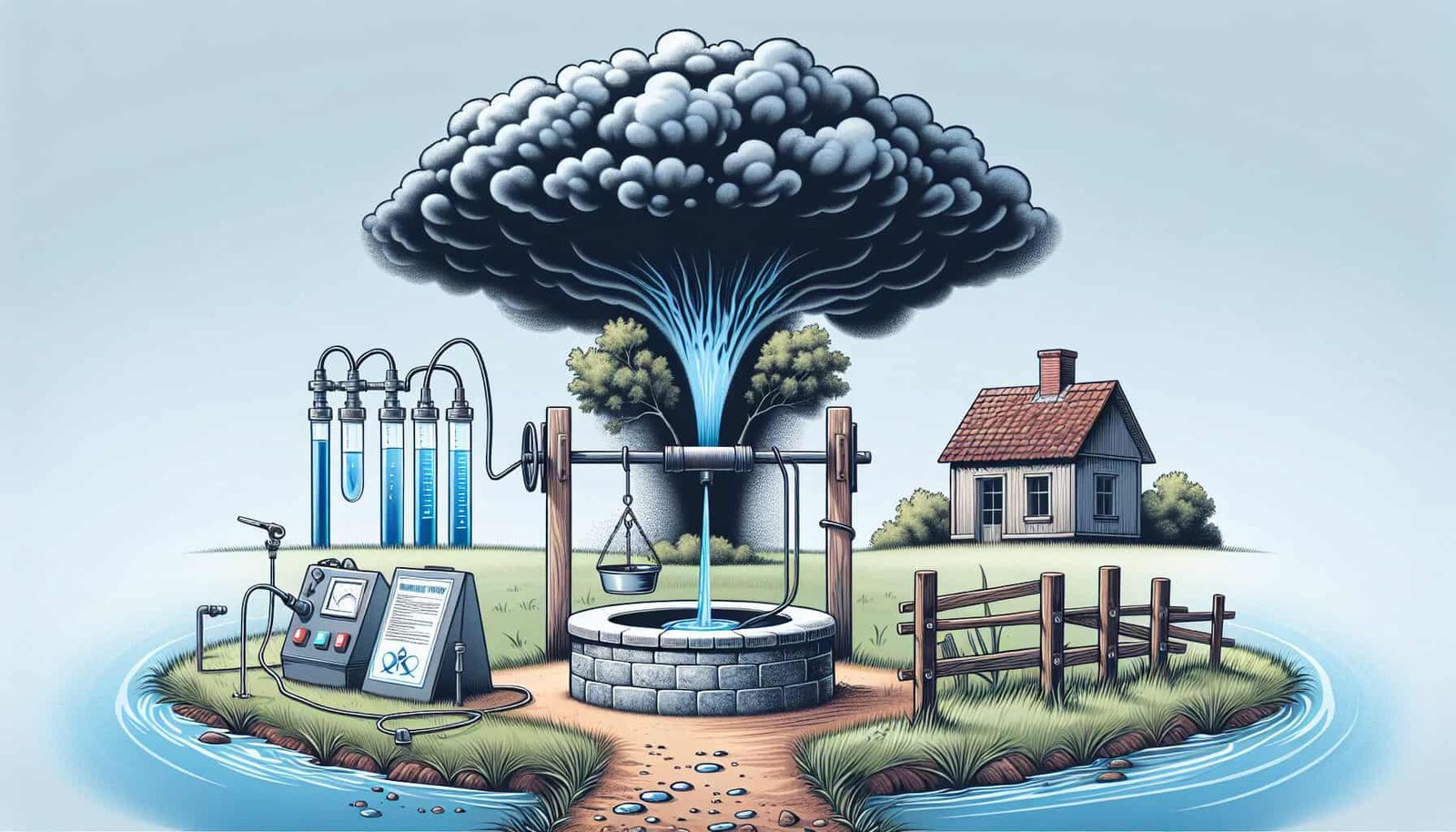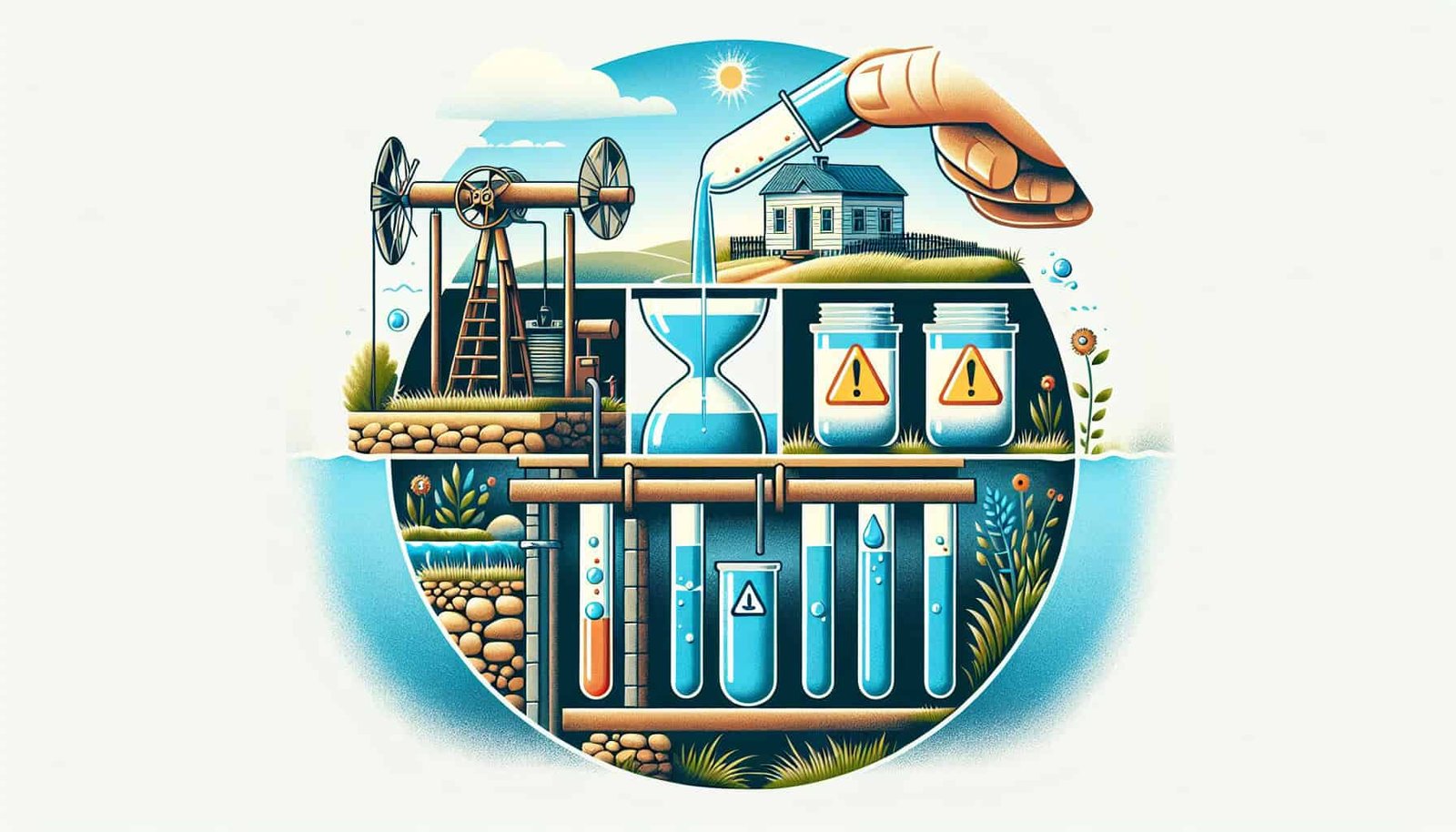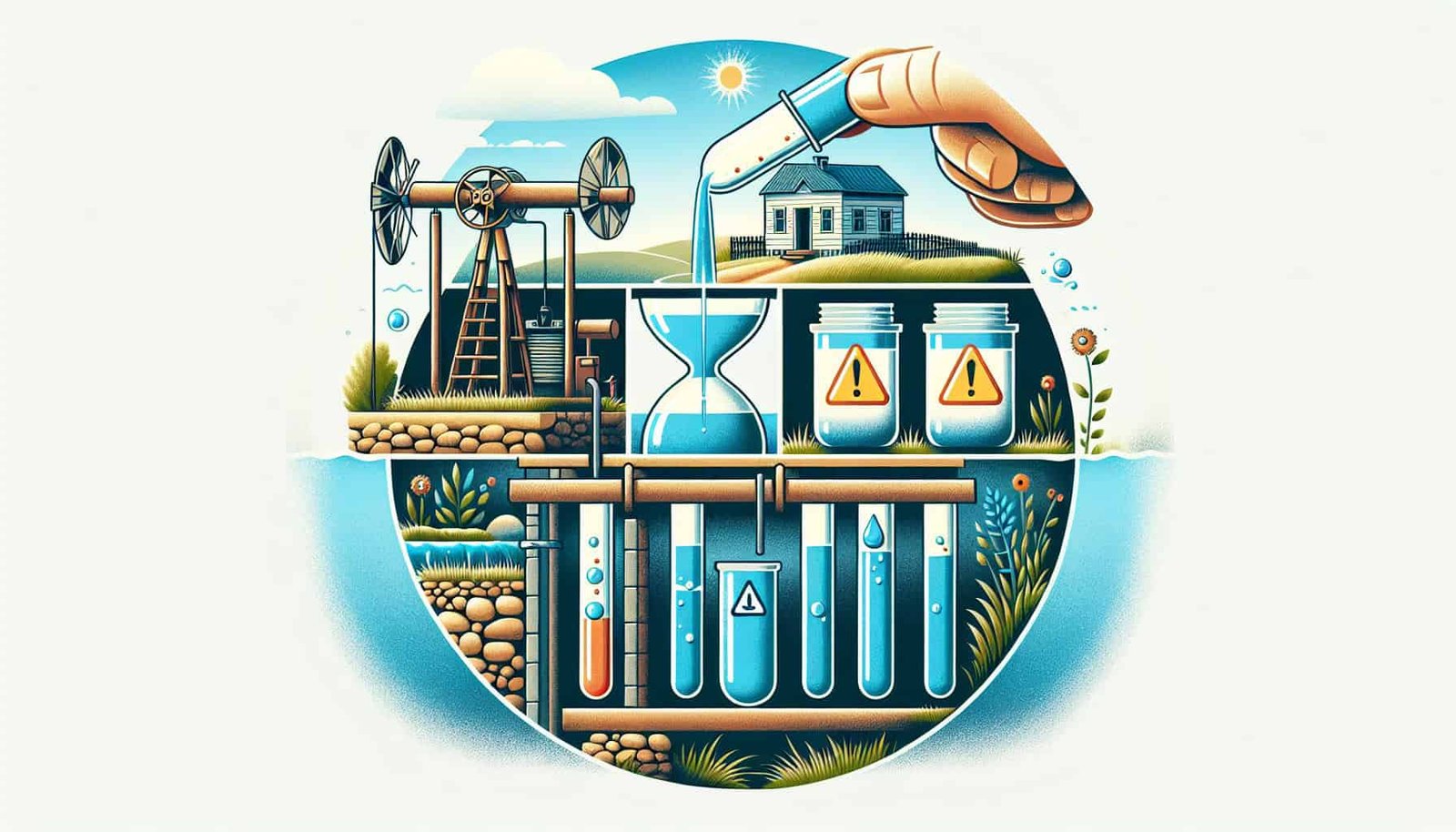Living in an area with well water testing for emerging contaminants can raise safety concerns regarding the quality of your well water. Understanding how to address these concerns becomes essential to ensure the health and well-being of yourself and your loved ones. In this article, we will explore effective strategies and practical tips to tackle safety concerns related to well water in areas where emerging contaminants are being tested. By following these guidelines, you can gain peace of mind knowing that your well water is safe and free from potential health risks.
Understanding Well Water and Emerging Contaminants
What is well water?
Well water refers to water obtained from underground sources, typically by drilling a well. Unlike public water systems, which are regulated and treated, well water is not subject to the same level of vigilance. Well water is vulnerable to contamination from various sources such as agricultural activities, industrial processes, and natural elements. Understanding well water is crucial for ensuring the safety and quality of this vital resource.
What are emerging contaminants?
Emerging contaminants are substances that have been recently identified or that are becoming more recognized as potential risks to human health and the environment. These contaminants include a broad range of substances, such as pharmaceuticals, personal care products, pesticides, and industrial chemicals. Emerging contaminants may not be regulated yet, but scientific research is continuously uncovering their potential harmful effects. It is important to test well water for these emerging contaminants to protect ourselves and the environment from their adverse impacts.
Importance of Testing Well Water for Emerging Contaminants
Why is well water testing necessary?
Testing well water for emerging contaminants is crucial because it allows us to identify any potential contamination that may be present. Unlike public water systems that are routinely monitored and treated, private well owners are responsible for ensuring the safety of their own water supply. Regular testing can provide early detection of emerging contaminants, allowing for appropriate mitigation measures to be taken in a timely manner.
What are the potential health risks?
The presence of emerging contaminants in well water can pose various health risks. The specific health effects depend on the type and concentration of contaminants present. For example, pharmaceuticals and personal care products may have detrimental effects on human hormone systems, while pesticides can cause acute or chronic toxicity. Industrial chemicals may be carcinogenic or have other adverse health effects. Testing for emerging contaminants helps identify potential health risks and guides us in taking appropriate measures to protect ourselves and our communities.
Legal regulations and guidelines
Currently, there are no nationwide regulations for emerging contaminants in private well water. However, some states have started implementing voluntary testing programs and have established guidelines for acceptable contaminant levels. It is important to familiarize yourself with the regulations and guidelines specific to your area to ensure the safety of your well water. Consulting with local health departments and water agencies can provide valuable information regarding legal requirements and recommended testing protocols.

Identifying Potential Contaminants in Well Water
Common contaminants found in well water
Well water can be contaminated by a variety of substances, both naturally occurring and man-made. Some common contaminants found in well water include bacteria, viruses, nitrates, pesticides, metals (such as arsenic, lead, and mercury), radon, and volatile organic compounds (VOCs). Understanding the potential contaminants allows us to prioritize testing for specific substances based on the local geological conditions, land use, and potential pollution sources.
Sources and causes of contamination
Contaminants in well water can originate from various sources. Natural sources include minerals leaching from rocks and sediments, while human activities like agriculture, industrial operations, and improper waste disposal contribute to man-made contamination. Factors such as proximity to agricultural fields, industrial sites, and septic systems can increase the risk of contamination. Identifying the sources and causes of contamination is crucial for effectively managing and mitigating the risks associated with well water contamination.
Understanding the risks associated with specific contaminants
Each contaminant found in well water carries specific health risks. For instance, bacteria and viruses can cause gastrointestinal illnesses, while nitrates, especially in high concentrations, can lead to methemoglobinemia, or “blue baby syndrome.” Chronic exposure to metals like arsenic or lead may result in neurological, developmental, and cardiovascular problems. Understanding the risks associated with specific contaminants helps prioritize testing, determine appropriate mitigation measures, and protect the health of individuals relying on well water.
Choosing a Reliable Well Water Testing Service
Researching and selecting a certified laboratory
When choosing a well water testing service, it is essential to select a certified laboratory that specializes in analyzing drinking water samples. The laboratory should have the necessary accreditations and certifications, such as those provided by the National Environmental Laboratory Accreditation Program (NELAP) or the Environmental Protection Agency (EPA). Researching and selecting a reputable laboratory ensures reliable and accurate test results.
Available testing methods
Various testing methods can be employed to identify and quantify emerging contaminants in well water. These methods may include analytical techniques such as mass spectrometry, liquid chromatography, and molecular biology approaches. It is important to choose a well water testing service that utilizes up-to-date and validated testing methods to ensure accurate and representative results.
Accreditation and certification of the testing facility
Accreditation and certification of the well water testing facility provide reassurance of its competencies and adherence to established standards. Look for certifications such as ISO 17025, which ensures the laboratory’s competence in performing specific tests. Similarly, accreditation from organizations like NELAP or state-certified programs further validate the laboratory’s proficiency and commitment to quality testing.
Cost considerations
The cost of well water testing can vary depending on the number and types of contaminants being tested, as well as the specific testing methods employed. It is essential to consider the cost when selecting a well water testing service. However, it is essential not to compromise on the quality and reliability of the testing results. Contacting multiple laboratories and comparing their services and price structures can help find a balance between affordability and effectiveness.

Sampling Techniques and Frequency for Well Water Testing
Proper sampling techniques to ensure accurate results
Proper sampling techniques are crucial to obtain accurate and representative results. It is essential to follow the guidelines provided by the testing laboratory for collecting water samples. This typically involves ensuring a clean sampling container, flushing the water line, and collecting the appropriate volume of water from the well. Adhering to these techniques minimizes the risk of sample contamination and ensures the reliability of the test results.
Recommended frequency of testing
The recommended frequency of well water testing may vary depending on factors such as the quality of the water source, potential contamination risks, and local regulations or guidelines. However, it is generally recommended to test well water at least once a year for physical and chemical properties, as well as bacteria. If specific emerging contaminants have been identified in the area or nearby wells, more frequent testing may be necessary. Regular testing allows for early detection of contamination and timely implementation of mitigation measures.
Factors influencing testing frequency
Several factors can influence the frequency of well water testing. These factors include changes in land use around the well, nearby industrial activities, agricultural practices, and geological conditions. Additionally, if there have been alterations to the well structure, maintenance activities, or repairs, it is advisable to conduct testing to ensure the continued safety and quality of the well water. Regular monitoring and awareness of these factors help guide testing frequency and identify potential risks.
Considering changes in land use or nearby activities
Changes in land use and nearby activities can significantly impact the quality of well water. For example, the conversion of agricultural land to residential or commercial use may introduce different types of contaminants into the groundwater. Similarly, new industrial activities or construction projects near the well may pose additional risks. Being aware of these changes and their potential impact on well water quality allows for proactive testing and appropriate mitigation measures.
Interpreting Well Water Test Results
Understanding units and measurements
Interpreting well water test results requires a basic understanding of the units and measurements used. Familiarize yourself with the units of measurement employed for various contaminants, such as milligrams per liter (mg/L) for metals or parts per billion (ppb) for certain organic compounds. Be aware of the acceptable limits or guidelines for each contaminant to assess the safety and quality of the well water.
Comparing results to established guidelines
To determine the safety of your well water, compare the test results to established guidelines and regulations specific to your area. These guidelines provide acceptable concentration limits for various contaminants, considering their health risks and potential exposure pathways. If you find that the test results exceed the allowable limits, it is important to take appropriate actions to address the contamination and protect your health.
Consulting with experts to interpret complex test reports
Interpreting complex test reports or addressing specific concerns may require expert advice. If you encounter difficulties in understanding the test results or assessing the health risks associated with certain contaminants, consider consulting with experts such as toxicologists, hydrogeologists, or local health departments. These professionals can provide valuable insights and guidance to ensure appropriate actions are taken to address any contamination issues.

Addressing Contamination Issues and Mitigation
Determining the source of contamination
Once a well water test indicates the presence of contaminants, determining the source of contamination is critical. This may involve evaluating nearby industrial activities, agricultural practices, or potential pollution sources in the vicinity. Identifying the source helps implement targeted mitigation measures to prevent further contaminant infiltration and protect the water supply from future risks.
Implementing appropriate well protection measures
Protecting your well from contamination is crucial in ensuring the long-term safety and quality of the water. Measures such as installing a well cap or seal, maintaining a proper distance between the well and potential pollution sources, and implementing regular well inspections can help prevent contaminants from entering the well. Taking these protective measures reduces the likelihood of contamination and minimizes the need for costly treatment or remediation efforts.
Treatment options for specific contaminants
In cases where contamination is detected, well water treatment can help mitigate the risks and ensure the quality of the water. Depending on the specific contaminants present, treatment options may include filtration systems, activated carbon filters, reverse osmosis systems, or ultraviolet disinfection. It is important to choose a treatment method that specifically targets the contaminants detected in well water. Consulting with water treatment professionals or experts can assist in selecting the appropriate treatment approach.
Long-term monitoring and maintenance strategies
Addressing contamination issues is not a one-time solution but requires ongoing monitoring and maintenance. Establishing a routine monitoring schedule and conducting regular testing ensures the effectiveness of mitigation measures and provides early detection of any recurring or new contamination events. In addition, practicing good well maintenance, such as regular well inspections, cleaning, and disinfection, helps maintain the integrity of the well and prolong its longevity.
Educating and Engaging the Well Water Community
Raising awareness about well water contamination
Raising awareness about well water contamination is vital in ensuring the safety and well-being of individuals relying on private wells. Educate the community about the potential risks, common contaminants, and the importance of regular testing. Utilize various channels such as community newsletters, social media platforms, and local events to disseminate information and raise awareness. When individuals are well-informed, they can take proactive measures to protect their well water.
Organizing community workshops and information sessions
Organize community workshops and information sessions to provide in-depth knowledge and guidance on well water testing, contamination issues, mitigation strategies, and treatment options. Inviting experts, such as representatives from local health departments, water agencies, or testing laboratories, can enhance the quality and credibility of the information shared. These workshops facilitate an open discussion among community members, encourage knowledge exchange, and promote collective action towards ensuring safe well water.
Sharing best practices for water quality protection
Sharing best practices for water quality protection helps individuals adopt proactive measures to safeguard their well water. Provide guidance on proper well construction, regular maintenance, and protective measures like maintaining a buffer zone around the well. Encourage the adoption of environmentally-friendly practices, such as reducing pesticide use and utilizing organic fertilizers, to minimize contamination risks. Empowering the community with knowledge and best practices improves overall water quality and strengthens well water safety.
Collaborating with local authorities and health departments
Collaboration with local authorities and health departments is essential in addressing well water contamination issues. Establish a partnership with these organizations to advocate for well water safety, develop testing programs, and ensure access to accurate and reliable information. Local authorities can help disseminate educational materials, distribute testing kits, or provide financial assistance for well water testing and treatment initiatives. Together, community members and local organizations can work towards improving the well water quality in the area.

Alternative Water Sources and Solutions
Considering alternative sources for drinking water
In areas where well water is contaminated or where emerging contaminants pose significant health risks, considering alternative sources for drinking water may be necessary. Public water systems, bottled water, or installing home water treatment systems can provide a reliable alternative. When exploring these options, it is crucial to consider factors such as accessibility, cost, and the effectiveness of contaminant removal to ensure consistent access to safe drinking water.
Exploring water treatment technologies
Water treatment technologies offer viable solutions for addressing specific contaminants in well water. Research and explore different treatment technologies, such as activated carbon filtration, ion exchange, or oxidation, to determine their suitability for removing emerging contaminants. Consulting with water treatment professionals or experts helps identify the most appropriate technology based on the specific contaminants present and the desired water quality.
Community-based solutions and water infrastructure
In some cases, community-based solutions and water infrastructure improvements may be necessary to address well water contamination. Collaborating with community members, local authorities, and organizations can help fundraise for community-wide treatment systems or establish centralized water supply systems. These infrastructure improvements reduce individual reliance on private wells and ensure consistent access to safe drinking water for the entire community.
Government Support and Resources
Available government programs for well water testing
Government programs exist to support private well owners in testing their water for contaminants. These programs may provide educational materials, testing kits, or subsidies for well water testing. Check with local health departments, water agencies, or environmental protection agencies to inquire about the available programs specific to your area. Taking advantage of these programs helps promote well water safety and encourages regular testing.
Financial assistance and grants for water quality initiatives
Financial assistance and grants are often available to support water quality initiatives, including well water testing and treatment projects. State or federal agencies, non-profit organizations, and private foundations may offer funding opportunities to promote safe drinking water. Stay informed about these financial assistance programs and grants to access resources that can help cover the costs associated with well water testing, treatment, or infrastructure improvements.
Accessing educational materials and resources
Educational materials and resources are readily available to assist well owners in understanding and addressing well water contamination concerns. Government agencies, universities, and non-profit organizations often provide detailed guides, fact sheets, and online resources that cover topics such as testing procedures, treatment options, and well maintenance practices. These resources can empower individuals to take the necessary steps to protect their well water and ensure its safety.
In conclusion, understanding well water and emerging contaminants is crucial for ensuring the safety and quality of private wells. Regular testing for emerging contaminants allows for early detection and appropriate mitigation measures if necessary. Identifying potential contaminants, understanding their sources and associated risks, and choosing a reliable testing service are essential steps in safeguarding well water. Proper sampling techniques, recommended testing frequencies, and interpreting test results accurately ensure effective monitoring and maintenance. Addressing contamination issues requires determining the source, implementing protective measures, and considering treatment options. Educating and engaging the well water community, exploring alternative water sources, and accessing government support and resources contribute to a proactive approach in protecting well water. By taking these measures, individuals can ensure safe well water for themselves, their families, and their communities.


